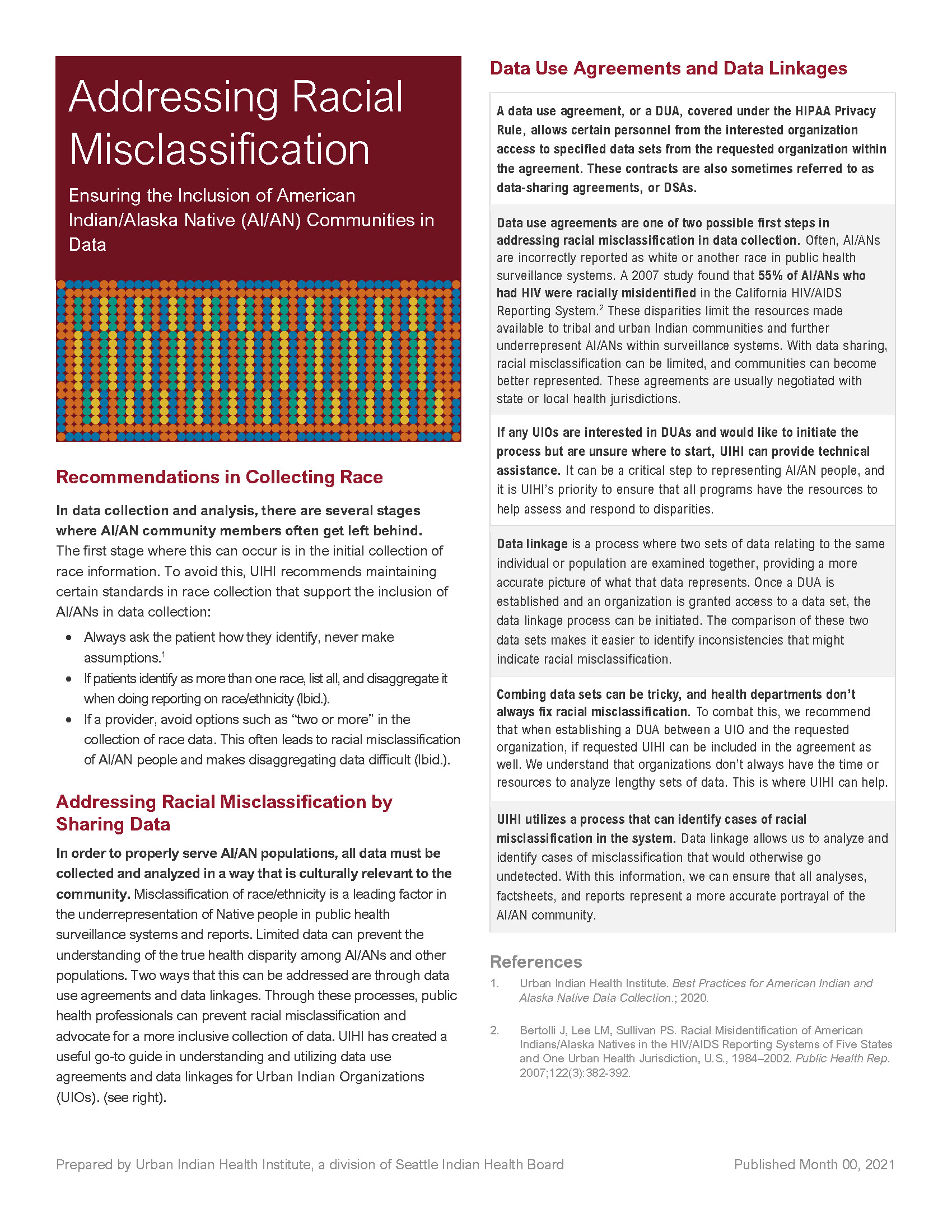Recommendations in Collecting Race
In data collection and analysis, there are several stages where AI/AN community members often get left behind. The first stage where this can occur is in the initial collection of race information. To avoid this, UIHI recommends maintaining certain standards in race collection that support the inclusion of AI/ANs in data collection:
• Always ask the patient how they identify, never make assumptions.1
• If patients identify as more than one race, list all, and disaggregate it when doing reporting on race/ethnicity (Ibid.).
• If a provider, avoid options such as “two or more” in the collection of race data. This often leads to racial misclassification of AI/AN people and makes disaggregating data difficult (Ibid.).
Addressing Racial Misclassification by Sharing Data
In order to properly serve AI/AN populations, all data must be collected and analyzed in a way that is culturally relevant to the community. Misclassification of race/ethnicity is a leading factor in the underrepresentation of Native people in public health surveillance systems and reports. Limited data can prevent the understanding of the true health disparity among AI/ANs and other populations. Two ways that this can be addressed are through data use agreements and data linkages. Through these processes, public health professionals can prevent racial misclassification and advocate for a more inclusive collection of data. UIHI has created a useful go-to guide in understanding and utilizing data use agreements and data linkages for Urban Indian Organizations (UIOs).
Data Use and Data Linkages |
Data use agreements are one of two possible first steps in addressing racial misclassification in data collection. Often, AI/ANs are incorrectly reported as white or another race in public health surveillance systems. A 2007 study found that 55% of AI/ANs who had HIV were racially misidentified in the California HIV/AIDS Reporting System.2 These disparities limit the resources made available to tribal and urban Indian communities and further underrepresent AI/ANs within surveillance systems. With data sharing, racial misclassification can be limited, and communities can become better represented. These agreements are usually negotiated with state or local health jurisdictions.
|
If any UIOs are interested in DUAs and would like to initiate the process but are unsure where to start, UIHI can provide technical assistance. It can be a critical step to representing AI/AN people, and it is UIHI’s priority to ensure that all programs have the resources to help assess and respond to disparities.
|
Data linkage is a process where two sets of data relating to the same individual or population are examined together, providing a more accurate picture of what that data represents. Once a DUA is established and an organization is granted access to a data set, the data linkage process can be initiated. The comparison of these two data sets makes it easier to identify inconsistencies that might indicate racial misclassification.
|
Combing data sets can be tricky, and health departments don’t always fix racial misclassification. To combat this, we recommend that when establishing a DUA between a UIO and the requested organization, if requested UIHI can be included in the agreement as well. We understand that organizations don’t always have the time or resources to analyze lengthy sets of data. This is where UIHI can help.
|
UIHI utilizes a process that can identify cases of racial misclassification in the system. Data linkage allows us to analyze and identify cases of misclassification that would otherwise go undetected. With this information, we can ensure that all analyses, factsheets, and reports represent a more accurate portrayal of the AI/AN community. |
References
- Urban Indian Health Institute. Best Practices for American Indian and Alaska Native Data Collection.; 2020.
- Bertolli J, Lee LM, Sullivan PS. Racial Misidentification of American Indians/Alaska Natives in the HIV/AIDS Reporting Systems of Five States and One Urban Health Jurisdiction, U.S., 1984–2002. Public Health Rep. 2007;122(3):382-392.

